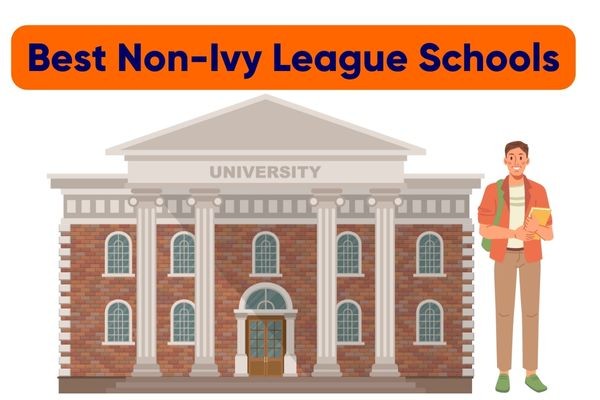The best non-Ivy league schools in the US include such notable names as MIT, Stanford University, and UCLA. While Ivy League colleges usually dominate the conversation over which are the best universities in the world, the best non-Ivy league schools can also offer you excellent educational opportunities from summer undergraduate research fellowships to research experiences for undergraduates. This blog will explore some of the most popular non-Ivy League schools and give you up-to-date information on college acceptance rates, average SAT or ACT scores, and the average GPA for new matriculants. We’ll also let you know what you need to do to get into the best non-Ivy League schools!
>>Want us to help you get accepted? Schedule a free strategy call here.<<
The Best Non-Ivy League Schools: Stats
Acceptance Rate: 4%
Average SAT: 1440-1570
Average GPA: 3.96
Massachusetts Institute of Technology (MIT)
Acceptance Rate: 4.8%
Average SAT Math Range: 780, 800
Average GPA: n/a
California Institute of Technology (Caltech)
Acceptance Rate: 6%
Average SAT: n/a
Average GPA Range: 3.5-4.0
Acceptance Rate: 4.1%
Average SAT Score Range: 1080-1600
Average ACT Score Range: 21-36
Average GPA: n/a
Acceptance Rate: 6.3%
Average SAT Score Range: 1520-1570
Average ACT Score Range: 34-35
Average GPA: n/a
Acceptance Rate: 7.2%
Average SAT: 1450-1540
Average GPA: ~4.1
Acceptance Rate: 3.4%
Average SAT Score Range: 1530-1560
Average ACT Score Range: 34-35
Average GPA: 3.9
University of California, Berkeley (UC Berkeley)
Acceptance Rate: 11.6%
Average SAT EBRW Score Range: 660 – 750
Average SAT Essay Score Range: 16-19
Average SAT Math Score Range: 680-790
Average ACT Score Range: 30-35
Average GPA Range: 4.15-4.30
University of Michigan-Ann Arbor
Acceptance Rate: n/a
Average ACT: Score Range: 31-34
Average SAT Score Range: 1350-1530
Average GPA Range: 3.9-4.0
Carnegie Mellon University (CMU)
Acceptance Rate: n/a
Average SAT: n/a
Average GPA: n/a
University of California, Los Angeles (UCLA)
Acceptance Rate: 9%
Average SAT: 1290-1510
Median Weighted GPA: 4.57
Median Unweighted GPA: 4.00
New York University (NYU)
Acceptance Rate: 13%
Median SAT: 1540
Average GPA: n/a
University of Southern California (USC)
Acceptance Rate: 10%
Average SAT Score Range: 1460-1540
Average ACT Score Range: 33-35
Average GPA Range (unweighted): 3.86-4.0
Acceptance Rate: 4.2%
Median SAT EBRW Score Range: 740-780
Median SAT Math Score Range: 780-800
Median ACT Score Range: 34-36
Average GPA: n/a
Acceptance Rate: 7.9%
Median SAT Score: 1560
Median ACT Score: 36
Average GPA: n/a
Georgia Institute of Technology (Georgia Tech)
Acceptance Rate: 36%
Average SAT Score: 1433
Average ACT Score: 31
Average GPA: n/a
University of North Carolina at Chapel Hill (UNC)
Acceptance Rate: 8.8%
Median SAT Score Range: 1370-1500
Median ACT Score Range: 29-33
Average GPA: n/a
University of Virginia (UVA)
Acceptance Rate: 16%
Average SAT: 1330-1500
Average GPA: n/a
University of California, San Diego (UCSD)
Acceptance Rate: 25%
Average SAT: 1300-1520
Median GPA Range: 4.11–4.29
University of Texas at Austin (UT Austin)
Acceptance Rate: 29%
Median SAT Score Range: 1230-1500
Median ACT Score Range: 27-33
Average GPA: n/a
The Best Non-Ivy League Schools: How Competitive are Non-Ivy League Schools?
Don’t make the mistake of thinking that because a school is not among the Ivy League colleges that it is among the easiest colleges to get into. This table shows how the college acceptance rates of Ivy League colleges and the best non-Ivy League schools are not that different:
The acceptance rates do not all match up, but even from this small analysis you can see that many of the best non-Ivy League schools are even more competitive than their Ivy League counterparts, which means they are just as selective as the Ivies.
For instance, Stanford and MIT have acceptance rates that hover around 4-7%, similar to or lower than the rates of most Ivies, showcasing their stringent admission standards. But, even with those similarities, there are several non-Ivy League schools that have double-digit acceptance rates, which are unheard of in the Ivy League. These high acceptance rates are usually found at state, public universities, such as the University of Virginia, the University of Texas at Austin and the University of North-Carolina and UC San Diego, that have mandates to admit as many qualified, in-state students as possible.
The Best Non-Ivy League Schools: Are They Just as Good?
The strength of their academic programs is another feature of these elite non-Ivy institutions. They offer specialized programs, particularly in engineering, technology, and science, that are often considered the best in the world. For example, MIT and Caltech are renowned for their offerings in STEM fields. This reputation allows them to attract top-tier talent and faculty, which leads to groundbreaking research that further encourages more investment, recruitment and international attention. Even still, the reputation and resources of these schools contribute to their competitiveness.
Many boast vast endowments, allowing for significant investment in research opportunities, facilities, and financial aid, enhancing the overall educational experience and drawing a diverse, talented student body. While Ivy League schools are known for their historic prestige and global alumni network, top non-Ivy League institutions match or exceed these benefits through strong global networking opportunities, career services, and global connections. Their graduates often achieve high levels of success and leadership in various fields, further elevating the schools' reputations.
The Best Non-Ivy League Schools: How to Get In
Excel Academically
Your GPA and standardized test scores (SAT or ACT) are critical, although it also depends on where you are applying. Many of the best non-Ivy League schools have become either colleges that do not require SAT or ACT, test-optional, or outright eliminated SAT scores or ACT scores from the admissions process. If you’ve already taken either test, you can still submit your scores at some schools if they are exceptional. If you’re planning on taking the SAT or ACT, you should aim for scores at or above the 75th percentile for the schools on your list.
But your GPA is even more important. Each school has a different policy on how they view or calculate GPA as part of your admissions profile, but ensuring you take challenging coursework, such as IB or AP classes, will not only demonstrate your academic preparedness but your fitness to be admitted. Research shows that students who challenge themselves with difficult coursework tend to perform better in college.
Develop a Strong Personal Narrative
“We admit students, not numbers,” so says CalTech. A part of the reason why many of the best non-Ivy League schools have gone test-optional is because of the debates around whether standardized test scores are an accurate portrayal of your academic prowess. With many schools believing that test scores are unreliable, they are more interested in getting to know what kind of person you are and what kind of student you’ll be, something that’s often referred to as “holistic admissions”.
Beyond grades and scores, your college personal statement, college essays, and college letters of recommendation should weave a coherent and compelling narrative about who you are, your passions, and what you bring to the campus community. Successful applications often tell a story that connects a student’s past experiences with their future goals, showcasing character, resilience, and a commitment to impact.
Pursue Meaningful Extracurriculars
Evidence suggests that students who show exceptional talent or leadership in extracurriculars for college are more attractive to competitive schools. Additionally, showcasing your innate curiosity and versatility through non-academic pursuits, such as non-credit online courses, sports competitions, or volunteer can also go a long way in demonstrating your passion for learning and exploring beyond the classroom. Admissions officers look for students who are likely to be active contributors to their academic community, and tangible projects or achievements can be persuasive evidence of your intellectual curiosity.
You should participate in as many student engagement activities for college that align with your interests and demonstrate leadership, initiative, and a depth of involvement. Quality over quantity is key; a focused commitment to a few activities where you’ve made a significant impact is more valuable than a long list of superficial engagements. However, you can also add shorter activities such as your participation in some of the top summer programs for high school students, as long as you show that you did something exceptional while involved.
Ace the Interviews
College interviews are becoming less and less common, but there are instances where you might be extended an interview invitation, for a variety of reasons, such as giving you a chance to explain a blemish on your record, or finding out more about your background. You should neither take this invitation as an admission or, conversely, as a sign of trouble. If offered, use the interview to reinforce your application's strengths, articulate your academic and professional goals, and demonstrate your interest in the school.
Practice answering common college interview questions and engaging in conversations about your interests and achievements. Effective interviews can significantly bolster your application by providing a personal touch and showcasing your communication skills.
FAQs
1. What makes non-Ivy League schools like Stanford and MIT competitive with Ivy League schools?
Non-Ivy League schools such as Stanford and MIT offer world-renowned programs, particularly in technology, engineering, and entrepreneurship, rivaling Ivy League institutions in prestige and academic quality. Their competitive edge also comes from groundbreaking research opportunities, global connections, and vibrant campus communities, making them highly sought after.
2. How important are SAT/ACT scores for admission to top non-Ivy League schools?
While top non-Ivy League schools like the University of Chicago and Northwestern University have holistic admissions policies, SAT/ACT scores are still an important component. However, many of these schools, including the University of California, Berkeley, have adopted test-optional policies recently, allowing students to decide whether to submit test scores.
3. Can extracurricular activities increase my chances of getting into schools like Duke or Vanderbilt?
Absolutely. Duke and Vanderbilt value well-rounded individuals who demonstrate leadership, commitment, and passion through their extracurricular activities. Quality over quantity matters; deep involvement in a few areas where you've made significant contributions or shown notable achievements can set your application apart.
4. What GPA do I need to get into top non-Ivy League schools like MIT or Stanford?
While there's no strict GPA cutoff, successful applicants to MIT or Stanford typically have near-perfect GPAs. However, these institutions consider the rigor of your coursework and improvement over time, so a less-than-perfect GPA won't necessarily disqualify you if other parts of your application are strong.
5. How can I stand out in my application to competitive schools like Caltech or Johns Hopkins?
To stand out, show how you're unique through essays that reflect your personality, values, and how you've overcome challenges. Caltech and Johns Hopkins look for innovation and intellectual curiosity, so highlight research projects, inventive solutions, or contributions to your community that demonstrate these qualities.
6. Are interviews required for admission to schools like Northwestern or Rice?
Interviews are typically optional at schools like Northwestern and Rice but highly recommended if offered. They provide an opportunity to show your genuine interest, articulate your achievements, and discuss how you align with the school’s values. Prepare by reviewing your application and practicing answers to common questions.
7. What financial aid options are available at top non-Ivy League schools?
Top non-Ivy League schools offer robust financial aid packages that can include grants, scholarships, work-study opportunities, and loans. For instance, Rice University has The Rice Investment, offering generous aid based on family income, making elite education accessible to students from diverse economic backgrounds.
8. How can I research the campus culture at schools like UCLA or NYU without visiting?
Utilize virtual tours, student blogs, and university social media accounts to get a sense of campus life at UCLA or NYU. Attending virtual admissions events and connecting with current students or alumni through university networks can also provide valuable insights into the student experience.


Like our blog? Write for us! >>
Have a question? Ask our admissions experts below and we'll answer your questions!
Comments